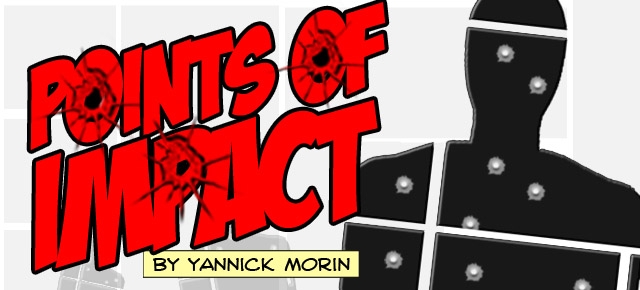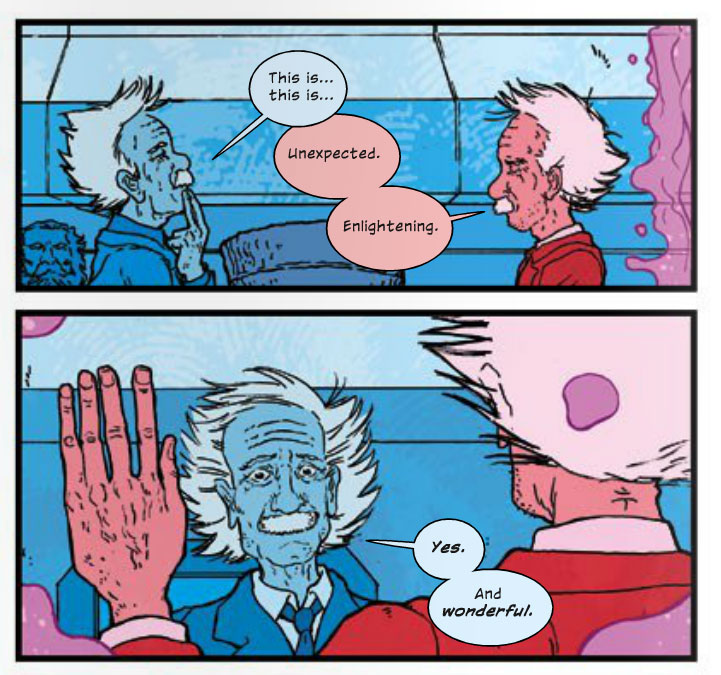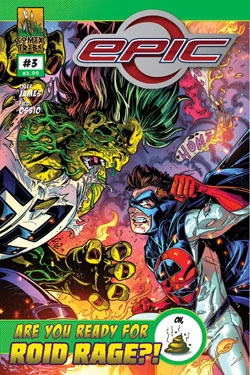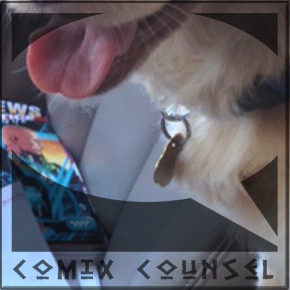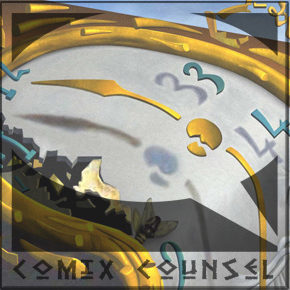Points of Impact – Week 15: Crossing the Streams
1st Disclaimer: Points of Impact contains so many spoilers it can practically replace reading your comics. Know what that means? Read your comics first!
2nd Disclaimer: For the sake of simplicity and since it’s impossible for me to know exactly who did what for the specific elements I usually examine, unless the creators come forward themselves to set me straight, from now on I’ll assume that everything in the comic stems from a joint decision by both the artist and the writer. I figure I’ll get it right most of the time if I give each 50% of the credit. I apologize in advance if I’m off from time to time, but I’d rather give too much credit than not enough where it’s due.
The convergent narrative tracks in Jonathan Hickman and Nick Pitarra’s THE MANHATTAN PROJECTS #4
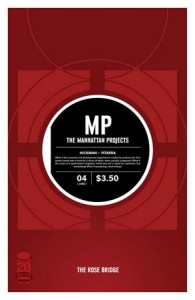 Writer: Jonathan Hickman
Writer: Jonathan Hickman
Artist: Nick Pitarra
Colors: Jordie Bellaire
Letters: Rus Wooton
This is the fifteenth Points of Impact and it appears to me there’s a notion that I often bring up and yet have never explained: narrative tracks.
For me, when I say narrative track , I mean a block of time composed of events in sequence. Whenever you have a group of consecutive scenes that you can link with and then and then , you have a narrative track. This chain doesn’t have to be unbroken either; other narrative tracks can cross it, taking center stage for a moment before letting the first track take precedence again.
Usually, tracks can be denominated using the easy monikers PAST, PRESENT and FUTURE, with the PRESENT track generally being the main one, that is the track upon which is built the most significant part of the story. By arranging the tracks in different ways, we obtain various narrative structures and the effects that they create. For example:
- PRESENT – PAST – PRESENT gives us the classic flashback.
- PRESENT – PAST – PAST2 – PAST – PRESENT represents a flashback within a flashback.
- PRESENT – PAST – PRESENT – PAST – PRESENT – PAST – PRESENT is what you get when using a framing device (in this case, the PAST track is often the main one while the PRESENT tract is the framing device).
- FUTURE – PRESENT is your typical flash-forward.
- And here’s a nice one: PRESENT – FUTURE – PRESENT – FUTURE2 – PRESENT – FUTURE3 – PRESENT. Recognize it? That’s how REBEL BLOOD #1 was structured with its hypothetical scenes.
Apart from that last one, the other structures are the most common ones you’ll find when reading comics. Sometimes however, as with our last example, you stumble upon some very intriguing arrangements, like the one we find in Jonathan Hickman and Nick Pitarra’s THE MANHATTAN PROJECTS #4.
Set in the days around World War II, the book follows the tribulations of the scientists working on the Manhattan Projects – yes, plural, because the creators posit that work on the atomic bomb was nothing but a front for far more dangerous and secret research. Among the enlightened individuals populating the story is of course Albert Einstein. You can already forget about that lively fellow who valued imagination over knowledge and showed his tongue for photo ops. Hickman and Pitarra’s Einstein is a surly old man, an alcoholic with a mean streak and a frighteningly pragmatic approach to every problem. Consulted about which of two delivery systems to use for the bomb? Just build both. Death Buddhist monk begging for the release of death? Just be, asshole. Werner von Braun proposing to share his research on rocket science? Kill all Nazi. This is not the benevolent genius we were expecting.
THE MANHATTAN PROJECTS #4 sheds some light on this shady characterization. After a seemingly unrelated prologue involving an alien encounter, the comic alternates between two narrative tracks: the main track (set in the present) and the blue track (set in the past). In the main track, Einstein comes to Richard Feynman, asking for his help reactivating a machine that he forgot how to use.
By the way, this is another classic example of foreshadowing as the device in question has already been introduced in issue #1 when Oppenheimer was touring the facilities with General Groves.
In the blue track, we find Einstein designing and building the machine. The special tint used for this track helps setting it apart from the main track and defining is as a flashback. You’ll also notice that anything related to the machine is tinted red in contrast. Kudos to colorist Jordie Bellaire for that! If you’re also reading Hickman’s other book SECRET, you’ll notice the same tricks are being used to color scenes and specific elements according to their significance.
These two tracks run side by side for the major part of the comic. While in the main track, Feynman gets closer and closer to activating the machine/portal, the blue track shows us Einstein approaching the completion of the building process. During this time, the two tracks seem to be parallel to each other: actions in one track basically mimic actions in the other. The characters’ actions all strive towards the same goal: opening the door .
However, once that goal has been attained, these two seemingly parallel tracks suddenly collide when a second Einstein steps through the portal! At this point, the two narrative tracks become convergent.
Why can we say that the tracks converge at this point? Because before that moment, there was no way for the reader to even suspect that Einstein wasn’t who he was presented to be. For all he knew, the surly Einstein sitting back and downing shot while Feynman works and the loveable inventor pictured in the flashback are one and the same. However, as soon as the second Einstein appears – we’ll call him Einstein2 – it completely transforms the way the reader can interpret not only the character himself but also the story up to now. And I’m not only talking about this specific issue but about the whole series.
Indeed, Einstein2 is far from a perfect copy of the original. For one, as he admits it himself, he’s far less intelligent, which would explain the roughness of both his manners with his supposed peers and of his solutions . It also explains why he needs Feynman’s help to activate a device he supposedly built himself. We can also extrapolate from his dialogue that not only is his moral compass pointing in quite another direction, but his interests also follow the same opposite route. This is one Einstein who shows no inclination towards science, this sweet apostasy . For the moment, we can only imagine in what field Einstein2 excels, if any at all. Judging by the weapon he used against his analog, he might very well be some kind of witch doctor.
One thing is certain however, the converging point has the effect of adding meaning to everything concerning the character that happened before. Every one of his contributions to the plot can now be examined and understood under a new light, a far more sinister one, I might add.
In that sense, the convergent narrative structure lets Hickman and Pitarra do what Link and Rossmo were able to do last week with REBEL BLOOD: retroactively insert characterization for a protagonist.
Thus, for their original use of converging narrative tracks, Jonathan Hickman and Nick Pitarra score a BULLSEYE with THE MANHATTAN PROJECTS #4.
Lesson Learned
Meaning doesn’t have to emerge solely from exposition; it can also come from the way narrative tracks are arranged. Among the various possibilities, a convergent structure presents the advantage of delaying the revealing of this information, thus providing the reader with two opportunities of interpreting the plot: once without and once with proper knowledge, each reading resulting in a different interpretation. It’s the difference between these two readings that creates a greater emotional impact for the reader rather than laying the real plot bare from the start.
Honorable Mentions
- In AMERICAN VAMPIRE #28, Scott Snyder and Rafael Albuqerque keep using the technique of having dialogue from one scene overflow into the next one for added meaning.
- Ed Brubabker and Sean Philips’ FATALE #6 shows some more ongoing omniscient narration instead of multiple-voiced caption monologues.
- As for Dan Abnett and I. N. J. Culbard, they use their captions as a way to bridge gaps in the depicted action in THE NEW DEADWARDIANS #4 of 8.
- RESIDENT ALIEN #2 of 3 shows some of the best dialogue on the shelves right now: simple, efficient and yet still lively and realistic.
Dishonorable Mentions
The opposite of last week! No one did anything that was remotely clumsy. Good job, gang!
That’s all for now! I’ll see you in seven!
Please click here to make comments in the forum!
Related Posts:
Category: Columns, Points Of Impact

